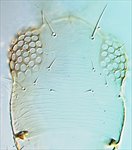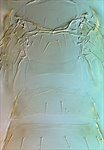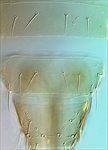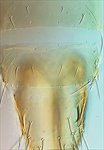
striatopennatus microptera head

striatopennatus antenna

striatopennatus microptera metanotum & tergites

striatopennatus microptera tergites VII-IX

striatopennatus macroptera tergites VII-IX
Generic diagnosis
Female macropterous or micropterous. Head almost as long as wide, prolonged in front of eyes; maxillary palps 2- or 3-segmented; eyes without pigmented facets; ocellar setae I absent; setae III lateral to fore ocellus and elongate; six pairs of postocular setae, setae II posterior to this row of setae. Antennae 7-segmented, segment I without paired dorso-apical setae, III and IV with sense-cones simple; III–VI with microtrichia on both surfaces. Pronotum with two pairs of long posteroangular setae; one pair of anteromarginal setae usually well-developed; three pairs of posteromarginal setae. Mesonotum with median pair of setae far from posterior margin; campaniform sensilla present. Metanotum with narrow anastomosing striae; median pair of setae far from anterior margin; campaniform sensilla absent. Fore wing first vein usually with irregular-spaced setal row or with no long gap in setal row, second vein with many setae equally spaced; clavus with five veinal setae and one discal setae; posterior fringe cilia wavy. Prosternal ferna entire; basantra membranous, without setae; prospinasternum broad and transverse. Mesosternum with sternopleural sutures complete; endofurca with spinula. Metasternal endofurca without spinula. Tarsi 2-segmented. Tergites without posteromarginal craspeda; V–VIII with paired ctenidia; VIII with ctenidia posteromesad of spiracles; VIII with comb represented by a few microtrichia laterally; IX with MD setae well developed; X with complete median split. Sternites II–VII with 2–10 discal setae, no posteromarginal craspeda; sternites III–VII with three pairs of posteromarginal setae, II with two or three pairs; laterotergites without discal setae.
Male similar to female; sternites III–VII each with transverse pore plate.
Biological data
Breeding only on species of Poaceae, and presumably on the leaves, but with no recorded genus-level specificity.
Distribution data
This is an Old World genus, with species in various warmer areas across this region, from southern Europe to Africa, India, Japan (Masumoto & Okajima, 2002), and Australia (Mound, 2011).
Nomenclatural data
Bolacothrips Uzel, 1895: 211. Type species Bolacothrips jordani Uzel, 1895, by monotypy.
Twelve species are listed in this genus (ThripsWiki, 2020), of which two are recorded from China:
graminis (Priesner, 1930: 6). (Bolacidothrips)
striatopennatus (Schmutz, 1913: 1002). (Thrips)
Relationship data
Thripidae sub-family Thripinae: this is a diverse group involving more than 230 genera. Within this large group, Bolacothrips is a member of the Thrips genus-group (Mound, 2002), but in contrast to the other species with similar abdominal ctenidia the sense cones on antennal segments III and IV are simple not forked.
References
Masumoto M & Okajima S (2002) Two Bolacothrips species (Thysanoptera, Thripidae) from Japan. Bulletin of the Japanese Society for Coleopterology 5: 119–127.
Mound LA (2002) The Thrips and Frankliniella genus groups: the phylogenetic significance of ctenidia. Pp. 379–386 in Marullo R & Mound LA [eds] Thrips and Tospoviruses: Proceedings of the 7th International Symposium on Thysanoptera. Australian National Insect Collection, Canberra.
Mound LA (2011) Grass-dependent Thysanoptera of the family Thripidae from Australia. Zootaxa 3064: 1–40.
ThripsWiki (2020) ThripsWiki - providing information on the World's thrips. <http://thrips.info/wiki/Main_Page>